|
Combined Educational & Scientific Session
ORGANIZERS: Fernando E. Boada, Ph.D. & John D. Port, M.D., Ph.D.
Thursday, 27 April 2017
| Room 312 |
08:15 - 10:15 |
Moderators: John Port, Michael Zeineh |
Slack Channel: #s_neuro
Session Number: CE01
Overview
This combined scientific and educational session focuses on data acquisition, analysis and translational application of multi-modal MR connectivity. Didactic lectures by subject experts will cover the state-of-the-art for diffusion and resting-state FMRI acquisition and analysis methods for connectivity studies. These talks bracket selected scientific studies that apply these techniques for the study of various neuropsychiatric and neurologic disorders. Ample time for discussion and audience participation will be allotted to identify hurdles to overcome and the most promising avenues for further research.
Target Audience
Trainees and scientists in MR physics / engineering and image processing and analysis, as well as neuroradiologists, neurologists and other clinical professionals interested in understanding the latest developments in connectivity for neuropsychiatric and neurologic disease.
Educational Objectives
Upon completion of this course, participants should be able to:
-Identify tradeoffs, strengths and limitations for different MR acquisition techniques for structural and functional connectivity;
-Interpret the results of translational studies that apply joint analysis of diffusion and resting-state fMRI data; and
-Recognize nuances of acquisition and analysis of diffusion and resting-state fMRI in neurologic and neuropsychiatric disease.
08:15
|
 |
DTI & rsFMR Imaging Acquisition Strategies for Connectivity Analysis 
An Vu
The Human Connectome Project (HCP) relies primarily on resting state functional MR imaging (rfMRI) and diffusion imaging (dMRI) to generate detailed maps of brain connectivity. Technical improvements and optimization of these methods have enabled significant increases in the spatial and temporal resolutions of fMRI and dMRI at both 3T and 7T. Ongoing technical developments and for acquisition will be presented, targeting higher spatial resolution while maintaining adequate SNR and sensitivity to functional signals. Results demonstrate that these approaches represent a significant advance in MR imaging of the human brain to investigate brain functional and structural connectivity that approaches the mesoscale.
|
08:45
 |
1077.
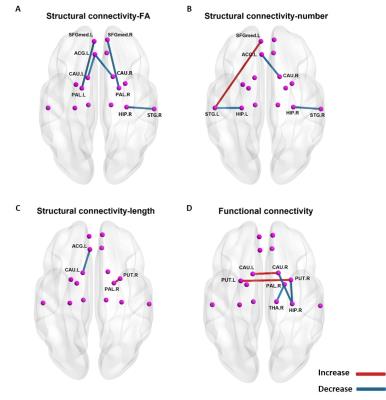 |
Dissociation of structural and functional dysconnectivity in first-episode drug-naive schizophrenia 
Jieke Liu, Li Yao, Wenjing Zhang, Su Lui, Qiyong Gong
Combining DTI and fMRI data sets, the present study revealed the dissociation of structural and functional dysconnectivity in a large cohort of first-episode drug-naive schizophrenia patients.
|
08:57
|
1078.
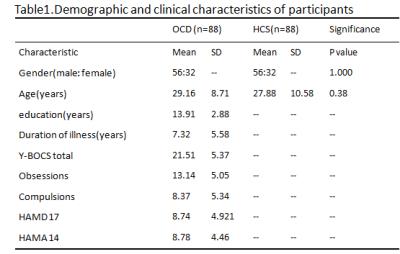 |
Altered effective connectivity of dorsolateral prefrontal cortex in obsessive-compulsive disorder: a Granger causality analysis with resting-state fMRI 
Hailong Li, Xinyu Hu, Ming Zhou, Lu Lu, Lianqing Zhang, Xiaoxiao Hu, Xuan Bu, Xiaoqi Huang, Qiyong Gong
In current study, we demonstrated the altered effective connectivity between bilateral dorsolateral prefrontal cortex(DLPFC) and other brain regions in obsessive compulsive disorder(OCD) using the Granger causality analysis of resting-state functional MRI. We found that the effective connectivity from the bilateral DLPFC to some brain regions are increased or decreased in OCD ,and DLPFC is the important information flow center. We also observed positive correlations between the abnormal causal effect and clinical symptoms such as obsession. These findings provide insight into OCD-related neural network disorders and may potentially guide clinical diagnosis and treatment of OCD in the future.
|
09:09
|
1079.
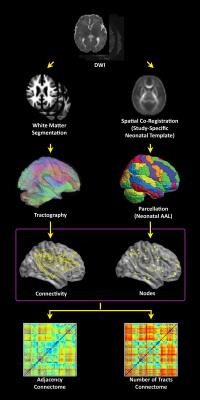 |
Reduced Functional Network Segregation is Associated with Reduced Structural Network Integration and Cost Pre-Operatively in Neonates with Complex Congenital Heart Disease (CHD) 
Vincent Schmithorst, Vince Lee, Jodie Votava-Smith, Richard Kim, Rafael Ceschin, Shahida Sulaiman, Hollie Lai, Jennifer Johnson, Joan De Toledo, Stefan Bluml, Lisa Paquette, Ashok Panigrahy
Neonates with complex congenital heart disease (CHD) pre-operatively show alterations in both structural network topology (as assessed via DTI) and functional network topology (as assessed via rs-fcMRI). Structurally, decreases in global efficiency, transitivity, and nodal efficiency are driven by decreased network cost and reflect alterations in white matter microstructure such as reduced fiber density. Functionally, CHD neonates display decreased network segregation in the later-developing frontal and temporal lobes, independent of cost, which likely reflect alterations at a more hierarchical level of architecture. These results may stem from different etiologies of brain dysmaturation (hypoperfusion vs. genetic factors).
|
09:21
|
|
Connectivity Analysis Methods Optimized to Identify Structural/Functional Brain Connectivity 
R. Todd Constable
|
09:51
|
1080.
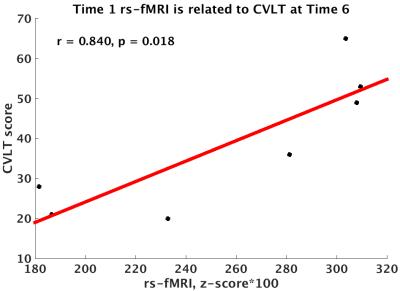 |
Functional and structural connectivity of the cingulate bundle related to future cognitive performance in MS 
Katherine Koenig, Erik Beall, Jian Lin, Ken Sakaie, Lael Stone, Stephen Rao, Micheal Phillips, Mark Lowe
This work assesses the relationship of resting state fMRI (rs-fMRI) and DTI of the posterior cingulum bundle to future cognitive performance. We find that rs-fMRI is related to performance on measures related to episodic memory, and radial diffusivity is related to performance on a measure of speed of processing.
|
10:03
|
1081.
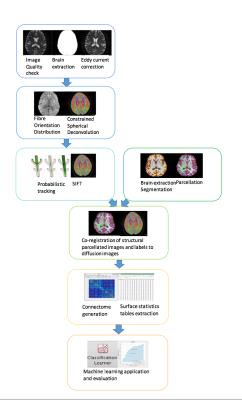 |
A multivariate machine learning framework for psychosis: integrating diffusion and structural MRI 
Vasiliki Chatzi, Rui Pedro A.G.Teixeira, Jacques Donald Tournier
Machine learning is increasingly being used in psychiatric research for patient classification and stratification. Current machine learning approaches are largely univariate with main focus on structural MRI and do not account for the significant white matter connectivity alterations associated with the disorder. With the steady growth of multi-centre multi-modal neuroimaging studies there is a need for multivariate machine learning frameworks that can integrate these different types of information. Here, we propose an automated multivariate machine learning pipeline to integrate state-of-the-art structural and diffusion features, based on well-established widely-available software packages to keep implementation and replication as simple as possible.
|
|







